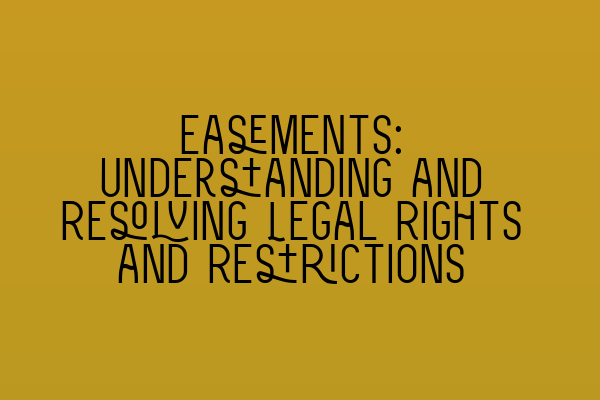Easements: Understanding and Resolving Legal Rights and Restrictions
Welcome to the blog of SQE Property Law & Land Law. In this article, we will delve into the intricate world of easements, aiming to help you understand the concept, its legal implications, and how to resolve any disputes that may arise. Whether you are a property owner, a potential buyer, or a legal professional, this article will shed light on one of the fundamental aspects of property law.
What is an Easement?
An easement refers to a legal right or interest that a person (known as the dominant owner) has over another person’s land (known as the servient owner). This right allows the dominant owner to use or enjoy the servient owner’s land in a particular way, often for the benefit of their own property. Easements can take various forms, such as a right of way, a right to light, or a right to access.
Easements are often created when two adjacent properties have a shared need or use of a particular area or facility. For example, a neighboring property might have an easement over your land to access a public road. Similarly, your property might have an easement over a neighbor’s land to access a shared water source. These easements help ensure smooth operations, minimize conflicts, and protect property rights.
Creating an Easement
An easement can be created in several ways, including by express grant or reservation, by implication, by necessity, or by prescription.
An express easement is created through a written agreement between the dominant and servient owners. This agreement must clearly specify the rights and obligations of both parties and be registered with the appropriate authorities to ensure its enforceability. If you are involved in an easement agreement, it is crucial to seek legal advice to ensure the document accurately reflects the intentions of all parties involved.
An easement by implication arises when it is necessary to give effect to the original intent of the parties or when it is essential for the reasonable use and enjoyment of the dominant land. This often occurs when a property is divided, and an implied easement is needed for the new landowner to access a road or utility services.
An easement by necessity occurs when there is no other reasonable way for a landowner to access their property, except by crossing a neighboring property. This easement is created to prevent landlocked properties and ensure access rights are maintained.
An easement by prescription, also known as a prescriptive easement, is acquired through long and uninterrupted use of another person’s land. If someone openly uses another’s land without permission for a specific duration, they may acquire an easement by prescription. This legal principle exists to balance the rights of property owners and ensure fairness in the use of land.
Resolving Easement Disputes
While easements are intended to facilitate harmonious land use, disputes can still arise between dominant and servient owners. If you find yourself in an easement dispute, it is recommended to seek legal advice from a property law specialist to understand your rights and options.
Common easement disputes include conflicts over the extent of the easement, interference with the dominant owner’s use and enjoyment, unauthorized changes or uses of the easement area, and disputes regarding maintenance and repairs.
The resolution of easement disputes often involves negotiation, mediation, or, in some cases, litigation. It is crucial to gather evidence, review the terms of the easement agreement, and assess the actions of both parties involved. Legal professionals can help analyze the situation, provide guidance, and represent your interests during the resolution process.
Conclusion
Easements play a vital role in property law, allowing equitable use and enjoyment of land while balancing the rights of neighboring property owners. Understanding the various types of easements and how they are created is essential for property owners, buyers, and legal professionals alike.
If you require professional assistance in dealing with easement matters or have any questions regarding property law, please do not hesitate to contact SQE Property Law & Land Law. Our team of experienced solicitors is ready to offer expert advice and guide you through the complexities of easements and any other property law issues you may face.
Related Articles:
